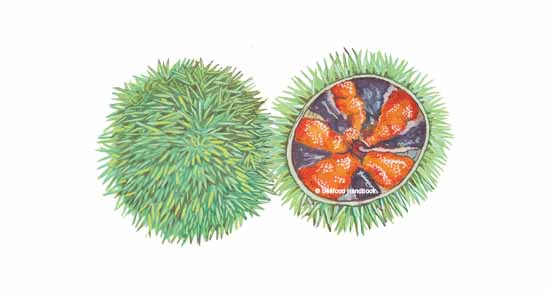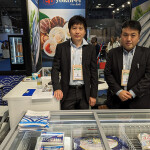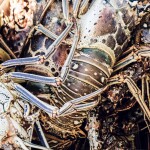Sea Urchin
Published on
January 23, 2014

There are about 500 species of sea urchins worldwide, but the major commercially valuable species in the United States are the red, green and purple sea urchins. The spherical echinoderms have a hard, spiny shell called a “test,” which contains a star-shaped mass comprising five skeins of gonads (in males) or roe (females); both are marketed as roe. The sushi designation uni is also widely used, because the Japanese are major urchin consumers. All three urchin species are harvested on the U.S. Pacific Coast; red and purple are found from Baja, California to Alaska, and greens are taken from Washington to Alaska. Only green urchins are commercially harvested on the Atlantic Coast, from eastern Canada to Cape Cod. The largest U.S. producers are California (red urchins) and Maine (green urchins). Most product winds up in Japan. West Cost urchins are harvested by divers. East Coast urchins are taken by diving and trawling.
Strongylocentrotus fransiscanus; S. drobachiensis; S. purpuratus
Sea urchin
Red sea urchin, green sea urchin, purple sea urchin
Oursin
Seeigel
Uni
Erizo de mar
There are about 500 species of sea urchins worldwide, but the major commercially valuable species in the United States are the red, green and purple sea urchins. The spherical echinoderms have a hard, spiny shell called a “test,” which contains a star-shaped mass comprising five skeins of gonads (in males) or roe (females); both are marketed as roe. The sushi designation uni is also widely used, because the Japanese are major urchin consumers. All three urchin species are harvested on the U.S. Pacific Coast; red and purple are found from Baja, California to Alaska, and greens are taken from Washington to Alaska. Only green urchins are commercially harvested on the Atlantic Coast, from eastern Canada to Cape Cod. The largest U.S. producers are California (red urchins) and Maine (green urchins). Most product winds up in Japan. West Cost urchins are harvested by divers. East Coast urchins are taken by diving and trawling.
The largest of the three urchins is the red, with a shell diameter of around 7 inches; greens are the smallest at around 1 1/2 inches. Urchin roe ranges in color from canary yellow to orange. The membrane holding the roe should be intact. Cleaned uni is soaked in an alum-salt solution that firms the membrane.High-quality uni has a sweet taste and a smooth, buttery texture. Male roe is silkier; female roe is textured more like fine cream of wheat.
| Calories: | 150 |
| Fat Calories: | 50 |
| Total Fat: | 10 g |
| Saturated Fat: | 0 g |
| Cholesterol: | 200 mg |
| Sodium: | 200 mg |
| Protein: | 10 g |
| Omega 3: | 0.5 g |
Uni can be eaten from the shell as is, or spread on crackers with a dash of lemon juice. Use it as sushi, in omelets, in rich seafood sauces or as a filling in crepes. Fresh urchin roe is best, since frozen roe loses some texture and the membrane sacs can break, but it’s still fine for sauces and such.
None
- Bake
- Boil
- Broil
- Fry
- Grill
- Pate
- Poach
- Saute
- Smoke
- Steam
Fresh: Roe
Frozen: Roe
Value-added: Salted roe, Canned roe, Fermented paste
Canada, United States






